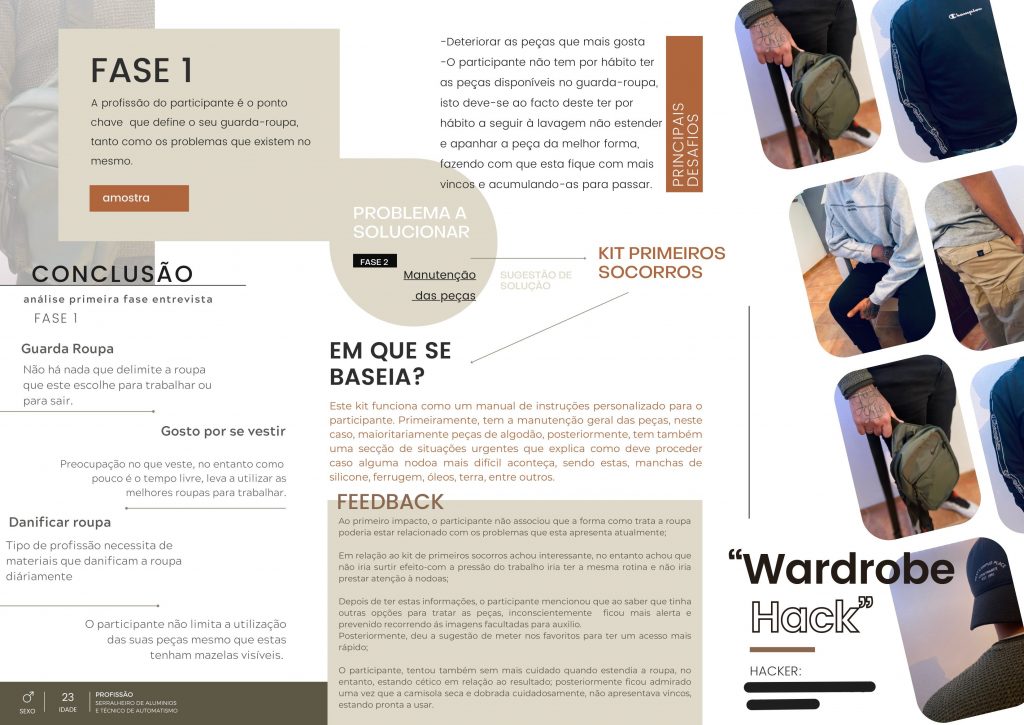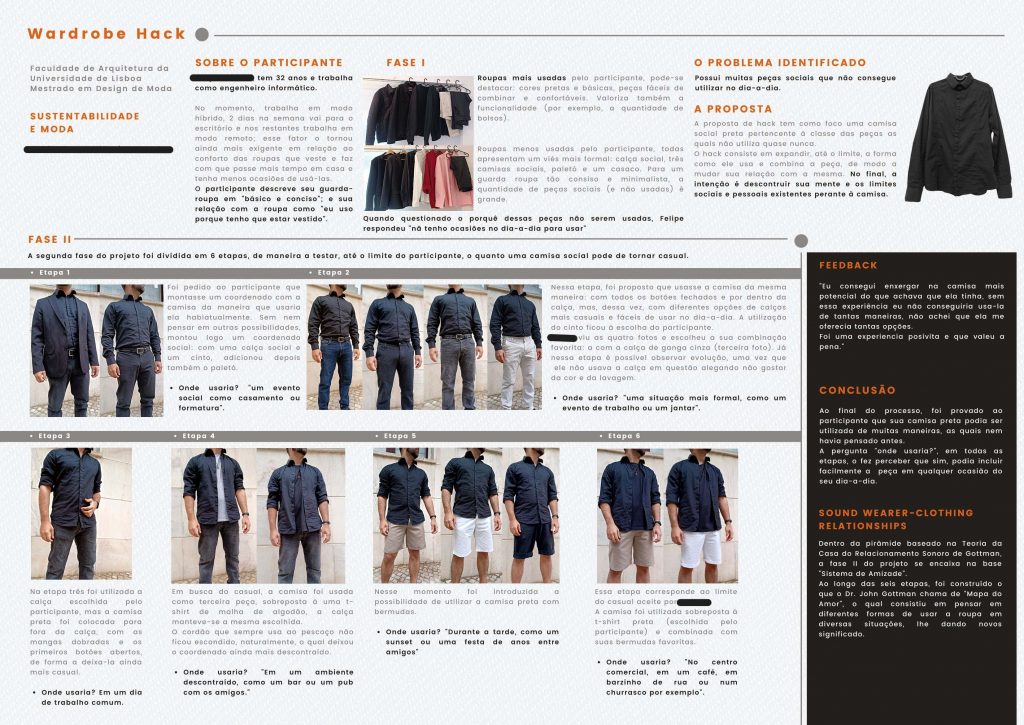Wardrobe Hack as an Educational Prompt
Author: Ana Neto, Lisbon, CIAUD, Research Centre for Architecture, Urbanism and Design, Lisbon School of Architecture, Universidade de Lisboa, Portugal
Aim of study
The use of wardrobe studies came up during my PhD project, which aimed to understand the relationships between wearers and their clothes, and how these can last for longer. Previous stages of the project pointed to the need of fashion designers to expand their design practice space to the territory of clothes in use, and therefore the goal of this study was to explore how fashion design students responded to the challenge of mediating wearer-clothing relationships, as an alternative role to the development of new products.
While the main aim of this exploratory study was educational, it prompted practical potential for behaviour-change, and qualitative insights that add to scientific knowledge on clothing use.

Design as for long been pulled into the industrial machine of massification, losing sight of the particularities of each person’s needs. This study was developed as a way for students to understand how wearer-clothing relationships are idiosyncratic, raising their awareness to the importance of being attentive to the issues wearers are facing and which require tailored approaches. This counters the usual process where designers get a sense of generic design situations (or problems) and devise a one-size-fits-many solution, which in practice is often not that fitting (becoming, therefore, wasteful).
Influence on approach and use of the method
The main method is an adaptation of Whitty and McQuillan’s (2017) original Wardrobe Hack, here used as an assignment for students in their 1st year of the Fashion Design Master’s Degree at the Lisbon School of Architecture. Before launching the assignment, other methods were used as small in-class exercises to prompt discussions on wearer-clothing relationships and to raise students’ awareness on aspects that undermine or nurture these relationships.
Firstly, drawing from Martin and Hanington (2012) Love Letter/Breakup Letter method, students were asked to write a love letter to the last garment they acquired, and a break-up letter to the last garment they discarded from their wardrobe. Letters were then passed around so that everyone could get to know others’ experiences. Secondly, students answered a small questionnaire on their oldest garment still in use (adapted from Neto and Ferreira, 2021), and answers were discussed in class. By using these exercises to introduce my previous research, students’ tacit knowledge on being in a relationship with clothes was brought to the foreground and, collectively, the group increased their theoretical sensitivity on the topic.

Finally, students were challenged to recruit a participant and conduct a wardrobe study (based on the original Wardrobe Hack), in order to identify issues their participant could be facing with any item or items in the wardrobe, and to develop an intervention (the hack) that could potentially improve one or more relationships between the participant and their clothes.
Data collected included notes from observations in class, project follow-up conversations with students, their presentations and the assignment outcomes handed in (a presentation poster + a report). Through thematic analysis, it was possible to distinguish the students’ findings on their participant’s issues, the kinds of hacks they came up with and the difficulties they faced, both in understanding their participant’s relationship with clothes, and implementing the hack.
Use of the results
Results were presented at a symposium on Fashion Design Education and will be published as a book chapter, and included in my PhD thesis. They can be useful for other educators seeking to introduce their students to wardrobe studies and a fashion design practice beyond product development. Even though the findings were written from an educational perspective, the examples it shares can also be useful for students just to increase their sensitivity to wearer-clothing relationships.
Insights generated by the method
Because this is a study that involves to levels of participation (students and their project participants), it generates different levels of insights, both theoretical and practical.

Theoretically, the data generated relating to students (their journeys, struggles and achievements) is relevant to help educators devise future strategies to support and nurture the skills needed for this kind of design activity. Additionally, there is data related to participants (their relationship with clothes) as reported by the students. Through project presentations, each student contributes to the “pool” of empirical knowledge the class shares on the topic, and through other dissemination channels it can reach the wider research community.
From a more practical perspective, the exercise provides a different, hands-on experience for students as they learn to design for relationships (attentive to wearer, garments, their relationship and context), and an often positive experience for their participants who are challenged to think and articulate their relationship with their clothes, and who become aware of their power to improve their well-being as it relates to clothing.
References:
Martin, B. and Hanington, B.M. (2012) Universal Methods of Design: 100 Ways to Research Complex problems, Develop Innovative ideas, and Design Effective Solutions. Beverly, Ma: Rockport Publishers.
Neto, A. and Ferreira, J. (2021) ‘“I Still Love Them and Wear Them”—Conflict Occurrence and Management in Wearer-Clothing Relationships’, Sustainability, 13(23), p. 13054. Available at: https://doi.org/10.3390/su132313054
Neto, A. and Ferreira, J. (2023) ‘Lasting Bonds: Understanding Wearer-Clothing Relationships through Interpersonal Love-Theory’, Fashion Theory, 27(5), pp. 677–707. Available at: https://doi.org/10.1080/1362704x.2023.2170706
Whitty, J. and McQuillan, H. (2017) ‘Wardrobe Hack’, in K. Fletcher and I.G. Klepp (eds) Opening up the Wardrobe: A Methods Book. Oslo: Novus Press, pp.128-130. Available at: https://omp.novus.no/index.php/novus/catalog/book/26
Link to work demonstrating the method:
Neto, A. and Forman, G. (forthcoming) ‘Mediating wearer-clothing relationships: a case study in Fashion Design Education’, in K. Scott, B. Curtis and C. Pajaczkowska (eds) The Future of Fashion Education: Speculation, Experiences and Collaboration, Routledge.